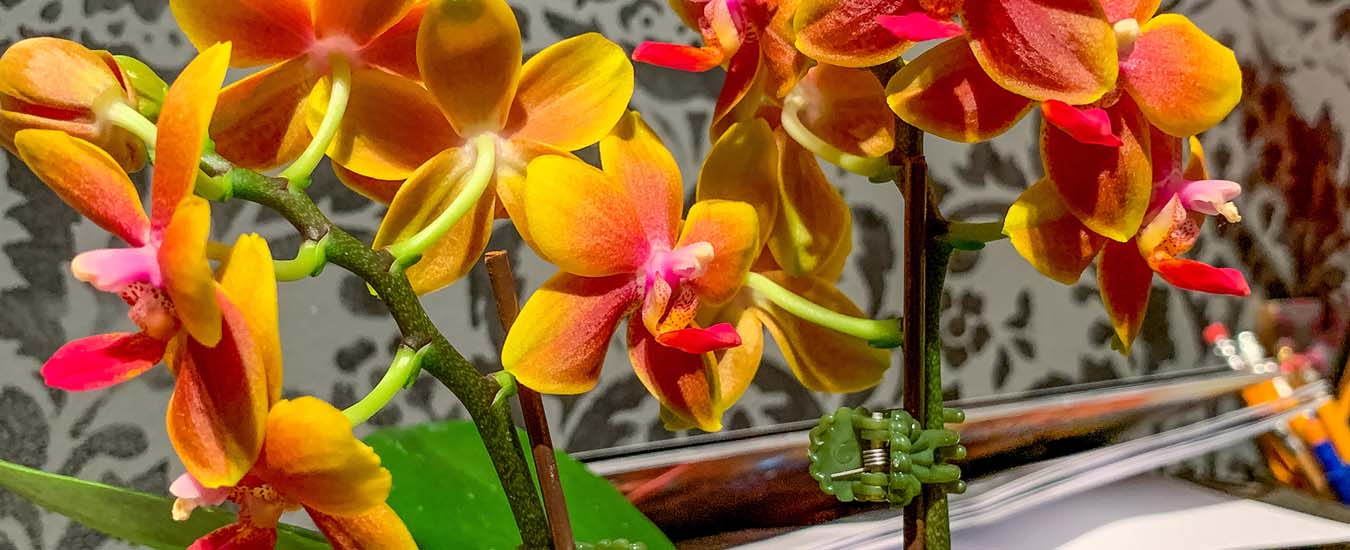Get your bloom on – indoors
Here’s nothing quite as cheering, in late fall and through until spring, as the sight of blooms growing in our homes. We’re in the season of poinsettias and Christmas cactus, along with all the glitter and glow of the season—but what about before and after the holidays?
We’ve all read stories (often from the floral trades) about how flowers are beneficial for our mental wellbeing at any time of the year. There certainly has been scientific research done on the benefits of flowers—whether blooming plants or cut flowers—to people of all ages in all seasons, and there are those researchers also exploring the potential medical and dietary benefits of edible flowers.
Think about the last time you gave or received flowers or flowering plants—didn’t your or the recipient’s face lighten with pleasure? We often bring a potted plant to the hospital or as a hostess gift when attending a dinner or other event; and in these seemingly endless days of COVID-19, a little cheering up is even more important than ever.
The good news for new houseplant fans is that most of these flowering species are available from local greenhouse and garden centres, flower and plant shops, and even at floral departments in grocery and department stores. Do check carefully, if purchasing at the latter options, to make sure that the plants are healthy and free of insects—and don’t buy plants when it’s frigid and blustery outdoors. Wait for a calmer, milder day.
Here, then is a selection of flowering plants for enjoying indoors all winter.
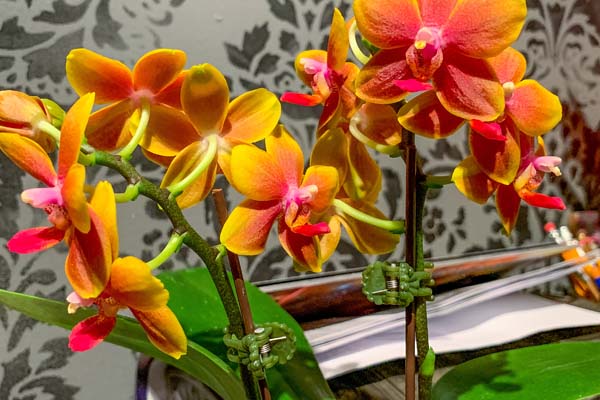
Moth orchids are long-blooming and tough as nails
The seasonal plants
Poinsettias are like dulse, dark ale, or mincemeat pie—those who like them, like them a lot. The rest of us avert our eyes from those flamboyant displays in grocery and department stores and florist shops. Put them in a bright and warm spot but away from drafts which can cause leaf yellow and drop. Although for years we’ve seen them advertised as toxic to pets, any self-respecting cat would have to eat a LOT of poinsettias to get a tummy-ache—and they’ll never do that! I personally love poinsettias for two months; when they start dropping their leaves and looking scraggly, I put them outside in the middle of a deep freeze before consigning them to the compost. So, don’t feel guilty if you do the same.
Christmas cactus. These tough plants can live for a very long time—and more accurately ought to be called holiday cactus—not out of some need for political correctness, but because some bloom around US Thanksgiving time, and still others in spring around Easter. They’re all part of the same genus (Schlumbergera) and unlike most of the plants we know as cacti, they grow in dappled shady areas, often high in trees, in coastal areas of Brazil. This gives you some hint of how they like to be grown in our homes: not too much direct sunlight, (this will turn the foliage shades of red) and in well-drained potting mixture. Don’t be in a hurry to repot them—they enjoy being a bit cramped in their pots. I put mine outside for the summer in bright but indirect sunlight and bring them in before frost. Along with the traditional flower colours of red, pink, orange and white, we’re seeing newer shades including one that is peach-gold in tone.
Cyclamen. This flamboyant delight blooms through autumn and into spring, with graceful swan-like flowers in shades of rose, red, hot pink, and white, along with some bicolour varieties. Cyclamen can be a bit needy—too much light or water and they’ll droop and get root rot, too little water and they’ll droop: what’s a gardener to do? Place them in an east or north location where they’ll get no direct sunlight, and water the pot from the saucer rather than the top of the soil where the growing base can develop root rot. There are a few hardy varieties that can be grown outdoors, but the common ones are purely for enjoying indoors. If the attractive foliage isn’t appealing enough after the blooming stops, you can compost them, but personally I like the foliage as much as the flowers.
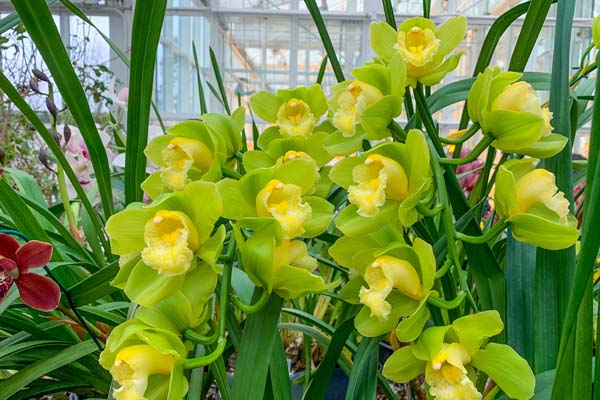
a green cymbidium orchid, which is fairly easy to grow in-home
The tropicals
Hibiscus are one of my houseplant weaknesses; a tad unfortunate because they can get quite large—some people have them as much as six-eight feet tall indoors, but I keep my older ones pruned to around four feet in height; the rationale being I can have more, smaller plants! Depending on variety, tropical hibiscus can boast flowers as large as salad plates and come in a rainbow of colours and multiple blends of hues. Some exciting varieties even change colour as the flower matures. My hibiscuses go outside in June and return indoors when the temperature is in low double digits, because they are not at all frost hardy. Bright light and good humidity are essential for happy hibiscus; I have a cool-mist vapourizer that I use around these and other humidity-loving indoor plants.
African violets are definitely habit forming—you can’t have just one, especially if you’re good at growing these colourful, fuzzy little plants. These are ideally suited for bright, indirect light and a warm room, not even requiring extra humidity to keep them happy. Too little light will make the foliage spindly and flowers few, so if your windows don’t suit, consider growing under lights for best flowering. Water with room-temperature water and take care not to get it on the leaves or central crown of the plant—usually once a week is sufficient. There are dedicated fertilizers designed to help promote growth in flowering plants, and you may use one of these if you choose.
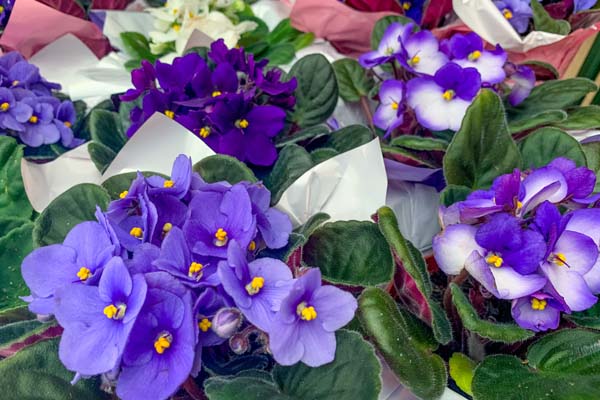
African violets provide an easy burst of colour
Streptocarpus are also known by the more charming name of Cape primrose. These African violet relatives are easier to grow, in my opinion, primarily because they don’t catch every bit of cat hair from my feline friends! In all seriousness, I bought an attractive Cape primrose several years ago, and it’s still going strong, so I added a few more. They thrive on bright light but not hot sun, so they tend to mostly be in my west windows. Like African violets, be careful when watering them so as not to soak the growing crown—water from the bottom, or carefully around the surface of the soil, taking care not to saturate the foliage.
Crown of thorns. This succulent from Madagascar is a relative of poinsettias, but to look at it you might doubt that—as the name suggests, it is a thorny plant, with leaves sporadically along its branches and sprays of small red, pink or yellow-to cream flowers. Best kept in bright light and on the dry side, they thrive on benign neglect and will bloom for months on end. The only issue I’ve ever had with them is occasional sessions of spider mite, but keeping the plant misted occasionally seems to deter them.
Phalaenopsis or moth orchids are the perfect gateway plant for those who have always wanted to try growing at least one orchid. These are ironclad tough and suited to growing in most homes—they don’t want too much sunlight, just some bright indirect light, and should be usually watered about once a week. Most are potted up in special bark growing medium to give them the excellent drainage they prefer, and when happy, they can bloom for weeks on end. Just ignore the dyed ones in bilious shades of blue, green, purple—you’ll know they’re dyed by the unnatural shades, and if they rebloom, they will be white. Just say no.
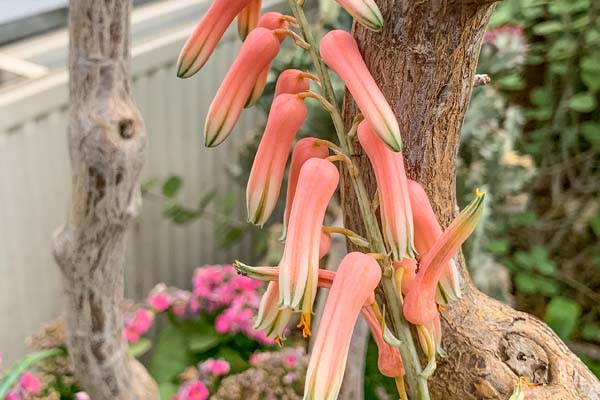
Succulents are tough plants requiring adequate sunlight and producing unique flowers; cactus in flower
Kalanchoe makes a perfect housewarming or hostess gift for someone who loves a pop of brightly coloured, long-lasting flowers. This succulent has fleshy, bright green leaves and produces clusters of single or double blooms in shades of yellow, orange, pink, red, magenta or pure white, plus a few that change colour as the blooms mature. They love bright light, so south or west windows are pleasing to them—but as with so many houseplants, avoid drafty spots. They are usually purchased already planted in a suitable succulent/cactus growing medium which provides good drainage. For those who forget to water plants, you’re in luck—kalanchoes really only need a watering every couple of weeks in active growing periods, even less in winter when they grow more slowly.
Other succulents produce flowers at various times of the year, and some of them are quite remarkable looking. I have a fairly…extensive collection of succulents ranging from the petite and bizarre Lithops, or living stones, to varieties of aloes, haworthias, echevarias, sedums, and more. (Yes, I have a lot of plants, no idea how many). The flowers of succulents aren’t always large or showy, but what they lack in size they make up for in colour, texture, and long bloom time. Many succulents put up long flowering stems that will have a procession of flowers lasting weeks, and while some have clusters of very petite flowers, others have colourful bell-like flowers in shades of orange, pink, red, and yellow, and almost resemble porcelain. Even when not in bloom, the plants boast unusually coloured and patterned foliage that makes them even more appealing.
For those who forget to water their plants—succulents hold their own moisture reserves. Especially in winter, just check them once a month. You’ll know if they’re thirsty.
